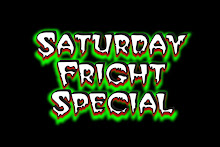
Reviewed by Rick Trottier
Just as it is hard for a waitress to deliver a tray of fifteen full-course meals without dropping something, it is hard for a director to deliver a feature film when you are trying to juggle many actors, story components and visual effects. Something will drop, and it won’t just be the other shoe. FALLEN ANGELS director/writer Jeff Thomas admits early in his commentary that he has Attention Deficit Disorder and his condition is obvious in this film.
FALLEN ANGELS is about a demon-infested derelict prison that is slated for demolition, until a ghastly discover is made. The prison has been the scene of grisly violence in the past and is now becoming the focal point of grotesque murders in the present. A team of law enforcement professionals work against time and terrible conditions to unravel the mystery of this sleepy rural town and the secrets it holds.
Beyond having a topic that will interest most horror fans, the immediate draw of this film is its huge cast of film “icons”. Among the luminaries, there is Kevin McCarthy, Reggie Bannister, Martin Kove, Ruth Buzzi, Michael Berryman, Kane Hodder, Christopher Knight and Adrianne Curry, all of which have very small roles in this film. It is only screen veterans Bill Mosely, Michael Dorn and “that guy” legends Joel Polis, Paul Linke, and Daniel Zacapa that have “sizeable” roles behind rookies Michael Kaliski and Farah White, who are truly the leads. Juggling such an unwieldy cast and the accompanying story built around such a large number of actors has its benefits and its drawbacks. Seeing such an intriguing list of celebrities will probably get viewers to rent or buy this film. Some of the performances, most notably Kevin McCarthy and Ruth Buzzi, are engrossing and add much needed support to FALLEN ANGELS. However, the hyperactive bouncing between characters and their story lines might be soothing to the director/writer and other ADHD persons, but most people will find the result jarring and hard to follow. Kaliski and White make good efforts at sincere performances, but their inexperience is evident, especially when they share scenes with the venerable McCarthy and Buzzi. Casting a film in such a way, that it creates a kind of “Hollywood Squares” effect usually does not work in the end.
The filming techniques, setting and lighting of this film is just as inconsistently successful. Any film set in a labyrinthine, leviathan of a building can potentially be a benefit, but in addition to interesting external architecture, the internal shots have to be lit well enough to see what is happening. That does not always happen. Some scenes are atmospherically illuminated with ominous reds or moody blues, but most of the time, the lighting is a mix of ponderous blacks and murky grays, so that the end product is often, “what did I just see?” Add to the troubled lighting are death scenes that are shot too close and are a mix of rapidly edited sequences depending on Fulci-esque blood baths, making the impact even more disconcerting. The outcome is unfortunate because this film has its heart in the right place.
At no time does FALLEN ANGELS descend into the abyss of the “horror-action” flick as too many movies do today. Despite some trite lines and exchanges at times, there is actually some occasional substantive dialogue and the underlying themes of the story, while well-trodden, are still effective and worthy. Even though the scares aren’t terribly scary, some of the story imagery can be entertaining, as is the atmosphere of the some of the set pieces. This film uses “old-school” special effects techniques rather than CGI, which lends a degree of charm. Polychrome Pictures touts itself as an “independent” and the old-style effects makes this film feel very “independent”, but in the end, that is a good thing. This film will probably appeal to a majority of younger, modern horror fans that are either unfamiliar or unimpressed with the work of directors of the past like Mario Bava, Dario Argento, William Castle and even John Carpenter. To the older eye, this film had potential that was unrealized and promise that did not fully bear fruit.
Included on the dvd is a small but interesting “extras” menu that has a segment with short “interviews” and/or “comments” by most of the cast. There is also “special effects” section where much of the “how to” of the masks and puppetry are explained. Finally, there is an audio commentary with director/writer Jeff Thomas and two other crew members. All of the extras add a layer of interest to the dvd that make the overall experience of watching FALLEN ANGELS entertaining, if not fully satisfying.
www.polychromepictures.com
www.fallenangelsthemovie.com


No comments:
Post a Comment